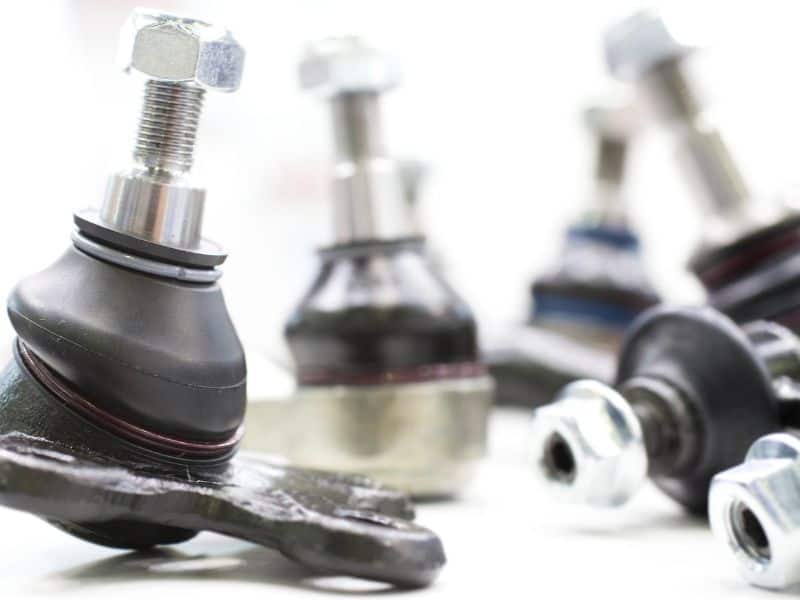The ball joint of a vehicle holds the wheel hub in place while still making it possible to move freely in the desired ranges set out by the manufacturer.
So when the ball joint starts wearing out, what are the bad ball joint symptoms you need to look out for?
- Squeaking Sounds When Steering
- Clunking Sounds When Going Through Bumps
- Free Play On The Wheel Assembly
- Vibrations When Driving
- Uneven Tire Wear
- Damaged Dust Boot
- Rust In And Around The Ball Joint
With the symptoms listed of a bad ball joint, let me explain precisely what is happening in each one.

7 Bad Ball Joint Symptoms
1. Squeaking Sounds
When the ball joint is on its last legs, it will start squeaking when you turn the steering wheel because the bearing surface on the inside has no lubricant anymore and is worn out.
This isn’t the only part that can cause squeaking while turning, the tie rods can also cause squeaking noises when turning, so it is best to see if you also have other symptoms.
2. Clunking Sounds
As the ball joint wears out, the spherical bearing can shrink in size due to abrasion as the lubricant dissipates over some time.
If it shrunk enough, it causes clunking noises, especially when driving over bumpy roads where the wheels experience load changes.
This shrinking of the spherical bearing can become quite hazardous as it can later pop out of the socket side and result in your whole wheel assembly separating from the suspension arms.
Here is a very informative video from 1A Auto demonstrating how a bad ball joint sounds and shows the upper ball joint that causes it:
3. Free Play On The Wheel Assembly
When the car is jacked up or on a hoist, and you take the tire in the 12 and 6 o’clock positions, wiggle it about, and feel any play, the ball joints are bad.
A good-condition ball joint will have no free play at all.
4. Vibrations When Driving
As you can imagine, when the spherical bearing starts shrinking in size as it wears out and there is play in the suspension system, this can cause unwanted movement and vibrations and can cause the whole vehicle to shake even at high speed.
Vibrations can cause more issues if not addressed, like interior rattles that start emerging.
5. Uneven Tire Wear
With the wheel assembly being able to move a fraction outside the tolerances given by the manufacturer, it can cause the tire to wear down unevenly.
With a movement of just a few millimeters, it can change the camber and caster values of the wheel, causing the said uneven wear.
6. Damaged Dust Boot
A damaged dust boot is one of two visual queues where the ball joint is bad; the dust boot protects the bearing surfaces of the ball joint by keeping out any foreign debris.
If the dust boot is damaged, the lubricant (grease) can escape, and dust, water, and other road grime can come between the socket and spherical bearing surfaces.
7. Rust
Rust is the other visual symptom to look for, minor surface rust is not an issue, but if you start seeing bubbling and flaking around the dust boot, it is time to replace the ball joint.
Once rust is prominent enough, it can push away the dust boot just enough to let road grime and even pieces of rust enter the bearing surfaces.
If you are planning on replacing the ball joint of your vehicle yourself, here is a brilliant video of ChrisFix demonstrating how to do it:
Final Thoughts On Bad Ball Joint Symptoms
The ball joint is a critical part of the steering and suspension of a vehicle, so whenever you suspect there is something wrong with it, look if you have one of the symptoms mentioned above and get it replaced if so.
Hopefully, you found this article helpful, and it will keep your vehicle on the road longer and give you many trouble-free miles.

FAQs
What Happens If You Drive On A Bad Ball Joint?
It can leak to catastrophic failure of the wheel hub disconnecting from the suspension and the driver losing control of the vehicle.
So if you suspect or know that one of the ball joints in the suspension is bad, get it replaced as soon as possible.
How Much Does It Cost To Replace A Bad Ball Joint?
It all depends on if only the ball joint can be replaced or the entire suspension arm; just a ball joint can cost up to $100, and the whole suspension arm can set you back from $500 up to $800 with another $100 to $150 for labor.
You will be charged anywhere from $150 to $950 to get your vehicle’s ball joint replaced.
Can Your Wheel Fall Off With A Bad Ball Joint?
Yes, not just the wheel but the entire wheel hub with brake caliper, disc, and wheel.
A ball joint has a very critical job of holding the vehicle’s wheel hub in place and letting the wheel hub move in the parameters set out by the manufacturer.
Do You Need An Alignment After Replacing Ball Joints?
A good rule to follow is whenever work is done on the vehicle’s suspension, it is an excellent reason to do a wheel alignment.
A wheel alignment costs between $50 to $168, and new front tires will easily cost above that, so instead, do it and know everything is aligned than driving a few hundred miles and seeing your tires wearing out unevenly.
